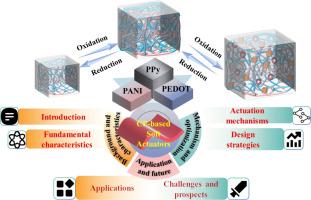Low-voltage operable conductive polymer actuators: Bioadaptive design strategies and emerging diversified applications
IF 9.6
1区 医学
Q1 ENGINEERING, BIOMEDICAL
引用次数: 0
Abstract
The persistent challenges of miniaturization, energy inefficiency, and mechanical rigidity in conventional actuators have driven a paradigm shift toward bio-inspired material systems. The conductive polymer actuators (CPAs) exhibit unprecedented advantages in bio-integrated systems, characterized by millivolt-level electrochemical responsiveness, dynamic biomimetic proprioception, and tissue-like deformability. These attributes not only transcend the limitations of traditional actuation mechanisms but also create synergistic material-structure-function relationships with biological environments. This review systematically summarizes the current progress and future trends of CPAs, with a focus on their fundamental characteristics, actuation mechanisms, design strategies, and application domains. The paper first elaborates on the fundamental characteristics of CPs, including low-voltage operation, high-efficiency response, superior flexibility/elasticity, self-sensing capabilities, cost-effectiveness/scalability, and environmental adaptability. Subsequently, it analyzes critical actuation mechanisms (redox-triggered shape morphing and ion migration-induced volumetric expansion), elucidating the underlying physicochemical principles. Furthermore, the review comprehensively discusses design strategies for CPAs, encompassing material modification, structural design, and system-level integration. Finally, representative applications are highlighted in cutting-edge fields such as biomedical and micromechanical systems, high-efficiency energy storage, smart wearable devices, bionics and robotics, along with perspectives on future research directions. This work not only provides theoretical foundations and technical guidelines for researchers but also fosters interdisciplinary collaborations, emphasizing the pivotal role of CPAs in advancing next-generation technologies.
Statement of significance
This review provides a comprehensive overview of conductive polymer actuators (CPAs), highlighting their unique bioadaptive characteristics and versatile applications. By focusing on low-voltage operation, high flexibility, and self-sensing capabilities, this work underscores the potential of CPAs to revolutionize biomedical devices, smart wearables, and soft robotics. It bridges interdisciplinary fields, offering a unified framework for researchers to advance next-generation biomaterials. This review serves as a valuable guide for future research, emphasizing the transformative impact of CPAs on modern biomaterials and their critical role in addressing current technological challenges.

低压可操作导电聚合物致动器:生物自适应设计策略和新兴的多样化应用。
传统执行器在小型化、能源效率低下和机械刚性方面的持续挑战推动了向生物启发材料系统的范式转变。导电聚合物致动器(CPAs)在生物集成系统中表现出前所未有的优势,其特点是毫伏级电化学响应性、动态仿生本体感觉和组织样可变形性。这些属性不仅超越了传统驱动机制的局限性,而且与生物环境建立了协同的物质-结构-功能关系。本文就注册会计师的基本特征、驱动机制、设计策略和应用领域等方面,系统地总结了注册会计师的发展现状和未来趋势。本文首先阐述了CPs的基本特征,包括低电压运行、高效率响应、优越的灵活性/弹性、自感知能力、成本效益/可扩展性和环境适应性。随后,分析了关键的驱动机制(氧化还原触发的形状变形和离子迁移诱导的体积膨胀),阐明了潜在的物理化学原理。此外,本文还全面讨论了注册会计师的设计策略,包括材料修改、结构设计和系统级集成。最后,重点介绍了生物医学和微机械系统、高效储能、智能可穿戴设备、仿生学和机器人技术等前沿领域的代表性应用,并展望了未来的研究方向。这项工作不仅为研究人员提供了理论基础和技术指导,而且还促进了跨学科合作,强调了注册会计师在推进下一代技术方面的关键作用。意义声明:本综述提供了导电聚合物致动器(cpa)的全面概述,突出了其独特的生物适应特性和广泛的应用。通过专注于低压操作、高灵活性和自我感知能力,这项工作强调了cpa在生物医学设备、智能可穿戴设备和软机器人方面的革命性潜力。它连接了跨学科领域,为研究人员提供了一个统一的框架来推进下一代生物材料。这篇综述为未来的研究提供了有价值的指导,强调了注册会计师对现代生物材料的变革性影响及其在解决当前技术挑战中的关键作用。
本文章由计算机程序翻译,如有差异,请以英文原文为准。
求助全文
约1分钟内获得全文
求助全文
来源期刊

Acta Biomaterialia
工程技术-材料科学:生物材料
CiteScore
16.80
自引率
3.10%
发文量
776
审稿时长
30 days
期刊介绍:
Acta Biomaterialia is a monthly peer-reviewed scientific journal published by Elsevier. The journal was established in January 2005. The editor-in-chief is W.R. Wagner (University of Pittsburgh). The journal covers research in biomaterials science, including the interrelationship of biomaterial structure and function from macroscale to nanoscale. Topical coverage includes biomedical and biocompatible materials.
 求助内容:
求助内容: 应助结果提醒方式:
应助结果提醒方式:


